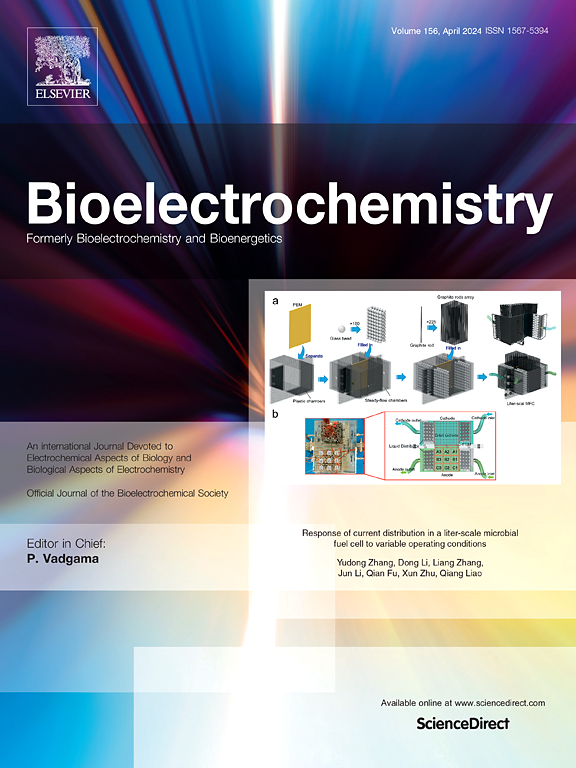高效检测细胞中尿嘧啶-DNA糖基酶活性的双模式DNA纳米级生物传感平台
IF 4.8
2区 化学
Q1 BIOCHEMISTRY & MOLECULAR BIOLOGY
引用次数: 0
摘要
分析尿嘧啶-DNA糖基酶(UDG)活性对于了解疾病进展和治疗中的DNA修复机制至关重要。本研究提出了一种结合电化学发光(ECL)和电化学阻抗光谱(EIS)的双模式DNA纳米级生物传感平台,用于高灵敏度和特异性的UDG检测。dna棱镜修饰电极固定化udg响应元件,形成稳定高效的检测界面。在UDG裂解后,释放的DNA片段开始快速的纳米级组装,显著放大了信号输出。ECL信号是由嵌入的[Ru(phen)3]2+络合物产生的,而EIS信号是由四联(4- n -甲基吡啶)卟啉(MnTMPyP)催化3,3 ' -二氨基联苯胺(DAB)与H2O2反应产生的。该平台的检出限为1.0 × 10−5 U/mL,有效验证了UDG抑制剂的抑制作用。此外,UDG活性与HeLa细胞数量之间存在很强的相关性。与商用UDG检测试剂盒相比,该生物传感器具有相当的灵敏度和增强的多功能性。值得注意的是,UDG在癌细胞中的活性明显高于正常细胞,这反映了恶性肿瘤中DNA修复需求的增加。这种区分不同细胞类型UDG活性的能力突出了其在癌症诊断方面的潜力,而这种生物传感器平台在临床诊断、癌症研究和药物发现方面有更广泛的应用前景。本文章由计算机程序翻译,如有差异,请以英文原文为准。
Dual-mode DNA nano-stage biosensing platform for efficient detection of uracil-DNA glycosylase activity in cells
Analyzing uracil-DNA glycosylase (UDG) activity is essential for understanding DNA repair mechanisms in disease progression and treatment. This study presents a dual-mode DNA nano-stage biosensing platform integrating electrochemiluminescence (ECL) and electrochemical impedance spectroscopy (EIS) for highly sensitive and specific UDG detection. A DNA-prism-modified electrode immobilizes UDG-responsive elements, forming a stable and efficient detection interface. Upon UDG cleavage, released DNA fragments initiate rapid nano-stage assembly, significantly amplifying the signal output. ECL signals are produced by embedded [Ru(phen)3]2+ complexes, while EIS signals result from the reaction of 3,3′-diaminobenzidine (DAB) with H2O2, catalyzed by manganese tetrakis(4-N-methylpyridyl)porphyrin (MnTMPyP). The platform achieves an exceptional detection limit of 1.0 × 10−5 U/mL, effectively validating the inhibitory effects of UDG inhibitors. Furthermore, a strong correlation between UDG activity and HeLa cell number is demonstrated. Compared to a commercial UDG detection kit, the biosensor exhibits comparable sensitivity with enhanced versatility. Notably, UDG activity is significantly higher in cancerous cells than in normal cells, reflecting the increased DNA repair demand in malignancy. This capability to distinguish UDG activity among different cell types highlights its potential for cancer diagnostics, while this biosensor platform shows promise for broader applications in clinical diagnostics, cancer research, and drug discovery.
求助全文
通过发布文献求助,成功后即可免费获取论文全文。
去求助
来源期刊

Bioelectrochemistry
生物-电化学
CiteScore
9.10
自引率
6.00%
发文量
238
审稿时长
38 days
期刊介绍:
An International Journal Devoted to Electrochemical Aspects of Biology and Biological Aspects of Electrochemistry
Bioelectrochemistry is an international journal devoted to electrochemical principles in biology and biological aspects of electrochemistry. It publishes experimental and theoretical papers dealing with the electrochemical aspects of:
• Electrified interfaces (electric double layers, adsorption, electron transfer, protein electrochemistry, basic principles of biosensors, biosensor interfaces and bio-nanosensor design and construction.
• Electric and magnetic field effects (field-dependent processes, field interactions with molecules, intramolecular field effects, sensory systems for electric and magnetic fields, molecular and cellular mechanisms)
• Bioenergetics and signal transduction (energy conversion, photosynthetic and visual membranes)
• Biomembranes and model membranes (thermodynamics and mechanics, membrane transport, electroporation, fusion and insertion)
• Electrochemical applications in medicine and biotechnology (drug delivery and gene transfer to cells and tissues, iontophoresis, skin electroporation, injury and repair).
• Organization and use of arrays in-vitro and in-vivo, including as part of feedback control.
• Electrochemical interrogation of biofilms as generated by microorganisms and tissue reaction associated with medical implants.
 求助内容:
求助内容: 应助结果提醒方式:
应助结果提醒方式:


